Ashleigh Gauch's Blog, page 3
March 30, 2018
Mind Segmentation and Task Transitioning: Why I Meditate Between Tasks

Last week I talked about exercise and how starting up a daily workout routine before I started my writing practice doubled my word count in about two weeks. In that post, I mentioned that I meditate every time I start a new task, and briefly touched on the concept of task segmentation.
Most writers have heard of the idea that editing and drafting use different parts of the writer’s brain and require different mindsets. Some famous authors would literally change outfits or physical hats when they were drafting, editing, or marketing/pitching their work to agents. There’s pretty good reasons for why.
The first is personal, but I’m sure many of my fellow writers (and ADHDers in particular) can relate. If I try to edit while I draft, I get so fixated on getting things right that I end up cutting my productivity to shreds. Accepting that there’s no such thing as a perfect first draft, or even a good one, that every first draft I’ll ever write is going to be crappy and that’s okay was the first step I took on the way to mind segmentation.
The second is a bit more broad. Breaking down tasks makes them seem more manageable, which means we’re more likely to do them. We’ve all heard the advice that, “write a novel” is a massive, overwhelming task when thought of as a whole, but drafting a specific scene or even outlining that scene before we draft it is far smaller. Taken this way, task segmentation makes sense. “Draft a scene,” is far less overwhelming than “write a scene and edit as I draft it so it’s as close to perfect as possible when I’m done so I don’t have to do a bunch of editing later, even though I know I’m still going to have to edit no matter how much work I do now.”
Whether I think about things in those words or not, that’s the implication of editing while writing. But in my personal practice, I take things a step further.
Covenant of the Hollow converted me from pantsing (E.G. writing by the seat of your pants, or without a written plan) to plotting for a simple reason. If I had to figure out what was happening in a scene as I wrote it, I wrote a lot less. So outlining a scene, or the “generative work” of creating that scene in my mind, became another segmented task.
Whether or not I outline my whole book (which I did for Covenant of the Hollow and my current project, Prisoner of the Hollow but not for Diary of the Hollow) or just one scene at a time is less important than the fact that I outline the scene and its important details before I start the drafting process.
Which brings me to meditation and task transitioning.
Now, writing a scene is broken into the following three tasks, each of which present a different mindset. “Visualize and outline the scene, including important sensory details, emotions, point of view, other characters and their motivations, and how it all relates back to the book’s theme,” then, “Write a crappy first draft of the scene and accept the fact that it’s going to need to be cleaned up later,” then, most likely further down the line, “edit the scene with the outline and the book’s outline in mind, making sure the scene accomplishes everything it needs to for its place in the book.” Notice how each of those stages require a different type of thinking?
We’re back to ADHD. People with ADHD often have a hard time transitioning between tasks. Neurotypical people do too, but to a far lesser extent. It’s hard to shift gears when your brain naturally loves to jump all over the place, and the blank space between “Task A is finished,” and “Start Task B” is a vacuum, and as with all things in nature, mind-vacuums are begging to be filled with STUFF.
What kind of stuff? Writer’s block stuff. Surfing Facebook stuff. Chatting with a friend stuff. Watching a YouTube video and getting sucked into a 3-hour long binge stuff. Eating everything in the fridge stuff. Starting a video game for just one round and playing for hours instead stuff. You get the idea.
Not writing stuff.
So what do? What I found helps the most is to quiet my mind with a 3-10 minute meditation when transitioning between any tasks, including transitioning from drafting scene 1 to drafting scene 2. Even though it’s the same mindset, quieting my mind before it can tell me “how much more interesting the buzz from my phone is than drafting scene 2,” and how “scene 2 will be just as hard to draft tomorrow as it is right now,” has made a huge difference.
I adore the Headspace mobile and desktop app for this reason alone. They have a number of mind quieting meditations, some of which come with visualization and reflection on a particular topic built in. At the end, when the narrator tells my mind to “be free,” I set an intention for when I open my eyes, so I’m ready to sink fully into whatever task I transitioned to.
If you don’t feel like paying for an app, a simple breathing meditation can be a simple alternative. Set a timer on your phone for 3-10 minutes, then set it down and close your eyes. Check in with the world around you. Sounds, smells, bodily sensations, the mood of your mind. After a few moments, focus on your breath. The length, the depth, where you feel it. Then, start counting. In breath, 1, out breath, 2. Count up to 10, then start over. Over and over again until the timer goes off. Thoughts are going to show up and distract you. Don’t judge yourself for that. If you catch yourself thinking, let go of the thought and come back to where you were when you were counting. Can’t remember? Start at 1. When the timer goes off, tell yourself (out loud if possible and not too embarrassing) what your intention is next, as though you were doing it. “I’m drafting scene 2.” Then sink into the task.
If you find yourself stuck in the middle of a task, where your brain is telling you you can’t go on or are spent for the day, try the 15 minute exercise burst from last week or the meditation from this week. It can really help, especially if you build a regular practice outside of just task transitioning. Meditation teaches that all of our thoughts are fleeting, including limiting beliefs about our own distractability or the feelings of anxiety that can crop up if we get stumped. It allows us to let these thoughts and feelings pass, rather than fighting them and giving them power, then move on and get whatever it is done.
Next week I’ll touch on my pre-writing habit ritual, and why I write at the same times every day if possible. I’ll also discuss habit triggers, and how to redirect unhelpful ones and deal with the need for consistency even if your day job gives you a random schedule.
What do you think? Have you had trouble transitioning between tasks? What does meditation do for you? I’d love to hear from you.
See you next week.
March 25, 2018
YA Urban Fantasy Book Review: Shadow’s Wake
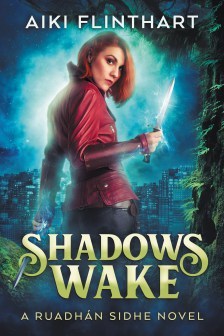
Shadow’s Wake is the debut novel in the Ruadhan Sidhe series by Aiki Flinthart. The author sent me a pre-release copy and shared an interesting tidbit: she learned how to throw knives so she could sketch out the action scenes better! That alone was pretty cool, but once I dug into the book, I knew I’d found something special.
The story opens with a young Rowan Gilmore backed into a corner at ChristChurch by two armed men who want to kidnap her for reasons she doesn’t understand. Her friend, Sarah, reveals the men threatened her mother and forced her to give up Rowan’s location. Angry and hurt, a dark power awakens within Rowan, and she ends up killing her attackers in cold blood.
Flash forward to the modern day, and we find Rowan and her mother Anna in Australia two years later. They haven’t had any signs of being pursued, and Anna is getting romantically involved with a mysterious Mitch in her company. Rowan, while training in the employee gym, makes the aquaintance of Mitch’s son Paul, who she accidentally knocks out in self defense. She’s able to convince him he fell and escapes having to explain her unusual strength, but ends up being forced to meander her way out of a date.
Paul, who isn’t used to being told “no” for anything, gives up after a mini-fit of disappointment and leaves. On her way home, Rowan gets mugged by two men and defends herself. Here she meets Fynn, a mysterious young man who seems to know something about why the men from her childhood were after her. Problem is, he has an agenda of his own.
What follows is a fast paced urban fantasy with strong sci-fi elements, combining Celtic myth, science, and young adult themes into a powerful action narrative. I really enjoyed the first person writing style and strong authorial voice that Flinthart employs throughout the novel. It kept me turning pages long into the night, as did the complex motivations of her supporting cast.
I also loved how Flinthart deftly avoids the “love triangle” trope so often foisted on female-led Urban Fantasy these days, and how she didn’t shy away from the sexually charged nature of some of the encounters between Fynn and Rowan.
The one complaint I have is that Paul felt a little underdeveloped, and the ending was less enticement and more cliffhanger. One of the major subplots in the book, the meaning of the mysterious word ocair, is left unsolved by the end, which was a bit of a disappointment. I would’ve kept reading to the next book either way, and it felt more like a tease than good storytelling.
5/5, thoroughly enjoyable read. Looking forward to the next one!
March 23, 2018
Working Out Broke My Writer’s Block

Time to reveal an open secret. I’ve got ADHD. Like, hardcore developmental I-couldn’t-get-homework-done-as-a-kid-but-passed-all-the-tests ADHD. And yes, you read the name of the blog right. I’m also a woman. And, to top all of it all off, I’m a writer.
Okay, now that I’m done being sarcastic, I should probably mention that all those things together are exactly as challenging as they sound. Probably more so. There’s a cacophony in my mind, like a concert going on all the time that only I can hear. And when I’m trying to pay attention to someone speaking, or something I’m supposed to be doing, like you know, writing, I have to push through the concert and force my bucking attention to stay there. Whether my interest is fully engaged or not.
This second point is really powerful. For those of you who are blessed/cursed with ADHD as well, you’ll likely have some idea of what I mean by interest fully engaged. My nervous system doesn’t let me do things unless I’m so hooked I lose track of time. “Well Ali, why don’t you just make yourself get engaged or interested? Think about the good things that’ll happen in the future, or the bad stuff!”
Rewards and punishments don’t really work an an interest-based nervous system. The problem with trying to think of the future as though it were now is that my brain is already off listening to the concert of my other thoughts or staring at some speck on the wall I hadn’t noticed before that kinda looks like Elvis’s head. And it’s easy to belittle this kind of problem when you don’t suffer from it. For my fellow neuro-divergents nodding along right about now, I have good news.
There are things you can do to help improve your attention. And for those of you who aren’t, but still want to help improve your focus for the times you suffer from wandering attention, stick around. You might find something useful here too.
Recently, I joined Weight Watchers. This isn’t an ad for them, though I’ve lost 16 pounds so far and am pretty happy with the program. When I joined, I was pretty sedentary, but over the past few weeks I’ve been doing daily workouts through one of their partners, Daily Burn. Again, not an ad, I’m just pretty happy with the service, though if you do decide to try it out they’ll give you a free month because they’re awesome like that.
At first it was friggen hard to get myself to do it. Why would I want to make my whole body sore when I could be sitting on my ample rear tapping away for the benefit of my readers and the kind authors who send me their books for review? But after about a week, I noticed something.
I have a FitBit tracker (all the brand name drops in this post!) and one of the features I use the most is the sleep tracking function. After a week, my total minutes spent in deep (theta level) sleep increased by fifty percent, my time to fall asleep decreased by thirty percent, and my minutes spent awake (people wake up periodically in their sleep naturally, so I’m not weird here) was cut in half.
So why should the writers in the room care? My word counts also doubled with no additional work time on the days I worked out. I’ll let that sink in for a sec. Remember what I said about interest based immune systems and immediate rewards? Seeing this was my hallelujah moment. And it gets better.
I’ll do a post on meditation next week, but I’ll simply note here that I’ve been pairing my workouts with 3 minute meditation segments when I transition between writing tasks. For me, writing tasks are segmented into four groups: Drafting (duh), Editing (reviewing notes from my writing group, line edits, structural commentary, reviewing my outline), Generative Work (outlining, prompt writing, world building, 1st person POV rants from characters so I can get their voice down), and Correspondence (answering your emails, sending out requests of my own for Covenant of the Hollow reviews, chatting with colleagues about events, etc).
Each of those tasks engages a different part of my writing brain and requires a different sort of attention, so the meditation smooths the transitions between them. I did this long before I started exercising, but the exercise gave a specific boost to my performance that, when paired with the meditation, engaged the ADHD state of hyperfocus without any additional effort on my part.
Meditation helps the body build additional dopamine receptors, which ADHD folks and those suffering from chronic anxiety and depression don’t have as many of as neurotypical folks. Exercise causes a MASSIVE release of dopamine when you’re done. That sore feeling after a workout, and the subsequent warmth all over your body? That’s a flood of dopamine similar to the flood you were looking for if you ever got into your fridge after a breakup or played video games for hours on end.
But wait, there’s more! Exercise also helps build new neural pathways. Translation: it makes learning and holding one’s attention easier. It does so by facilitating production of BDNF, a hormone essential to the production and maintenance of neuron pathways. If you meditate during or after exercise, it can also help with the construction of those wonderful dopamine receptors I talked about earlier, which help your brain become more responsive to the “feel good” you get after doing something hard. Or working out.
Armed with this information, I tried walking on my treadmill when I got stuck on a particularly difficult transition point working on Covenant of the Hollow. Anyone who’s read it and is reading this would understand why I’d get stuck a few times working on it. It’s an immense plot spanning centuries, involving equal parts political thriller, cosmic horror, hard science fiction, and alternate history genres.
Getting on the treadmill with no distractions (and this is the key right here, because it didn’t work with music or a podcast) broke through all my blocks within 15 minutes. Who wouldn’t want a cure for writer’s block as simple as throwing on some running shoes and heading outside or hopping on the treadmill? I got hooked.
Keep in mind exercising didn’t eliminate my need for medication. It did, however, increase its effectiveness. I can feel when my Ritalin LA kicks in, and after a workout, I can jump right into my work without the itch to hop on Facebook or call up a friend instead of whatever set of tasks I laid out for myself that day.
I’m thinking of doing a series on ADHD, attention, writer’s block, anxiety, and tools and techniques you can use to break through it. It’ll be primarily aimed at creative types, but anyone can use it.
What do you think? Is that something you would be interested in? Is there a particular topic you’d like me to cover?
Let me know in the comments, or shoot me an email over on my contact page. I’d love to hear from you.
March 21, 2018
Science Fiction Book Review: Breakers of the Dawn
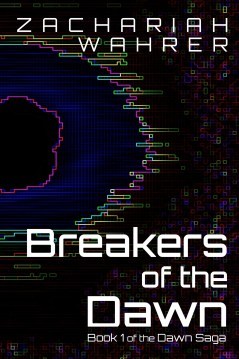
Breakers of the Dawn is a sci-fi thriller by Zachariah Wahrer. It’s the first book in his Breakers series.
It’s an incredibly ambitious blend of the hard sci-fi, thriller, and space opera genres, and for all the big ideas Wahrer presented and the intriguing characters I saw the story through, I really wanted to love it. But let me back up a bit.
The story opens from the POV of our first protagonist, Felar, a hardcore military woman who rose to the ranks on her own merits in the Ashamine military, as she presents information about what Initiates (read: recruits) in the lower ranks can look forward to if they work hard enough. She’s immediately accosted by a former classmate who failed out of the Founder’s Commando (think of them as like Special Ops) training regiment and believes that Felar slept her way to the top. He ignites a fight between her and his top student, then she blacks out as she’s accosted again by a group of men she can’t fight off. We’ll get back to that in a minute.
Next, we meet Wake, an engineer working in the Ashamine mines who is falsely accused of sabotaging (or neglecting, the charges aren’t quite clear) lifts running up and down the mountain he works on. The accident happens off screen and in the past, though he does have a dream sequence that sort of explains it. Someone neglected safety procedures and ten miners died. He’d submitted a bunch of requests for better parts, was instructed to use the faulty parts, and the accident stopped waiting to happen.
Next on the list is Maxar, a convict (don’t recall learning his crime) forced to fight in brutal cage matches on the Bloodsport asteroid for the amusement of the upper class in Ashamine society. He plans and executes his escape later on, but here we simply learn a bit about him and his attitudes toward the empire.
Then, we meet Tremmilly, a foolish and rather naive woman from a backwater planet who grew up underneath the thumb of one of the many Ashamine cults not officially recognized by the government. Her caretaker tells her a prophecy involving 5 people (you can see where this is going) and that she happens to be one of them and must bring them together to stop the mysterious Breakers. We don’t yet know what or who the Breakers are, but the beginning of the prophecy sounds menacing enough to Tremmilly to spur her on her later adventures.
POV number 5 is Lothis, a young boy who has lived his entire life in a single room, with a single routine, and knows nothing but that room, that routine, and the AI training him. He becomes far more important later, but this chapter simply introduces him.
POV 6 is the Founder, the dictatorial leader of the Ashamine empire. We find out right away that all is not as it seems with both the war against the psychic insect race the Entho-la-ah-mines, nor with government as it’s supposed to be run in this world. He orders an underling to put down a rebellion, but we don’t find out much about the plan until later, when the underling leads a chapter of his own.
POV 7 is Cazz-ak-tak, an Entho who has been sent back to the human-overtaken Entho homeworld on a special mission. In his introductory chapter we’re introduced to the concept of the Great Thought, a psychic pool where all the Entho minds in the universe can meet, and where collective joy and sorrow is shared across the peaceful species. We also find out that the Ashamine empire has acted as an effective terrorist cell against the Entho species, and that this has turned out terribly for all involved.
The aforementioned Founder’s underling is also a POV character far later, but for spoiler reasons I can’t speak much about his role in the plot. His chapters along with Cazz’s, Lothis’s, and Maxar’s were among the more vivid and interesting in the book. That’s about all I can say about him.
As I mentioned earlier, I love a lot of the cool ideas and tropes Wahrer played with in this book, but the whole thing ended up bogged down by passive language and telly storytelling. As soon as I started getting invested in a character or scenario, I ended up dealing with a barrage of over-explaining about how they felt or thought about something, or passive recounting of what the “had done” prior to the chapter. Overuse of gerunds (“ing” verbs) abounded and all in all, the clumsy writing style made it hard to read. It’s nothing a good writing group or competent line editor couldn’t fix, but since I had to read it as written, it did drag down the whole experience.
Also, Felar is raped in that first chapter, but apart from being a reason for her transfer to another planet, the trauma is never really addressed later in the book. She just kinda… forgets it. And that upset me being a rape survivor myself. I’ve known women in the military who were raped. No amount of training makes you just “shake it off.”
All of that said, the world Wahrer built is what pushed me through to the end. I won’t spoil much, but I will say he did leave a bunch of dangling plot threads for the sequel.
3/5 stars. If you can get through the clumsy writing style and some of the problematic themes, I think it has potential.
March 19, 2018
Dystopian Thriller Book Review: No More Heroes
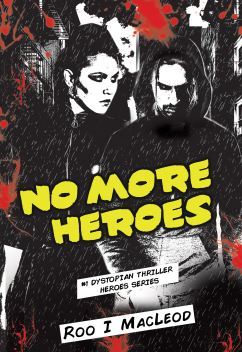
No More Heroes is a dystopian thriller by Roo Macleod, the first in the Heroes series. It takes place in England, specifically London’s Ostere district in the far future, so both setting and character voice were refreshing for dystopian thriller.
It opens with Ben Jackman describing the horrors of life on the street in Ostere. He’s soon pulled aside by an old friend-turned-enemy of his, Marvin, who gives him a bag for safekeeping and asks him to get it to his mother-in-law. Shortly afterward, bombs go off in the town square, and he’s sent running for his life. He ditches the bag, not realizing its importance, and when he returns it’s gone. Everyone he knows seems to want that bag. He’s a marked man from then on, both by the richest men in the area and the cops, as well as his own gang when they find out.
And that’s most of the plot. The author’s writing style is gritty and unique, but I found myself struggling to get into the story to begin with. I didn’t learn much about Ben besides his angst until almost a third of the way through the book, and that’s about when I became interested in what was going on with the bag and what fate might befall his friends. In some places I felt like there were too many characters to keep track of, all with one and two syllable names that sounded similar or at least weren’t said enough times to give them significance.
That said, his action sequences were fantastic. Once I did get into the rhythm of the story, I found myself drawn into the more action-heavy portions, and loved that the author didn’t make Ben into a practical superhero in every encounter. There were several where he laid low and described things as he heard them, waiting for other factions to play things out rather than jumping in and risking his life. You’d think that would make for a boring story, but in this case it was fitting with the character and added increased tension to those scenes. Well done.
I also got a strong sense of the setting from the protagonist’s monologues. There were some truly unique (if vulgar) turns of phrase in some of them, even if a few felt like we’d shifted out of first person into a sort of omniscient just to capture the ambiance.
I figured out where the bag was and what was in it before the author intended, but I could also chalk that up to good foreshadowing and writers’ intuition. To sum up, the strongest points were setting, writing style, and well written action sequences. The weakest parts were character development, pacing, and sometimes overly lengthy dialogue sequences.
The ending also wasn’t quite satisfying, as several plot threads were left dangling for the next book in the series. All in all it was an enjoyable romp, but as a character driven author and reader, it wasn’t quite what I’d usually read.
4/5 stars, great for people deep in the action genre, but expect a slow build if you’re looking for strong characters.
March 12, 2018
Urban Fantasy Book Review: Broken Realms
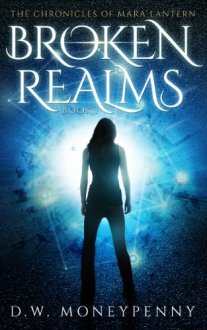
Broken Realms is a fast-paced Urban Fantasy by D.W. Moneypenny, a former journalist who currently lives in Portland, Oregon. It’s the first installment in the five-part Chronicles of Mara Lantern series.
The book opens with Mara Lantern (our reluctant protagonist) arguing with a good friend about her younger brother’s insistence on using an old cell phone to make believe communication with their dead father. Mara is a gadget whiz, a grease monkey who delights in older technology with all its moving parts despite the current era’s determination to march toward the future.
She boards a plane heading back home to Portland and things get…weird. Flashing blue lights, sudden altitude change, rapid shifts in the other passengers, and then she’s faced with a clone of herself carrying a glowing blue object. This other self is pursued by a teenage boy trying to talk her down from using said object for purposes we don’t find out until far later. Mara reaches out and touches her other self, an explosion happens, and suddenly she awakens on the side of the river with passengers from the flight all floating around her.
No casualties. The press hails it as a miracle, but all is not as it seems. Here we meet our next set of protagonists, two investigators trying to solve the mystery of the plane crash. I can’t get too deep into their plotline in my synopsis or I’ll end up entering spoiler territory, but suffice to say their scenes generate conflict and intrigue when we do get them, as they suspect Mara of being the cause of the explosion.
The author’s writing style is clean and functional, descriptive when he needs to be and passable when he doesn’t. I live in the Pacific Northwest region and have visited Portland many times. He captures the feel of the city quite well and I enjoyed that aspect of the story. The side characters Ping and Sam (again, spoilers if I get too deep into their identities) ended up being far more interesting and believable than the protagonist.
Her character arc centers around accepting that the Universe is bigger than she is, and that she has near god-like powers to shape it. During the first half of the book her doubt is believable, but as the story goes along, I found myself more annoyed and disbelieving than tense when she continued to refuse to accept the truth before her eyes until the VERY end. The side characters and fantastic world building carried me through, but I’d be lying if I said the tension in the story had anything to do with the protagonist’s fate toward the end.
3.5/5, I borrowed the next two and plan on reviewing them. If the series doesn’t get any better, I’ll probably drop it.
March 9, 2018
Weird Western Book Review: Coilhunter
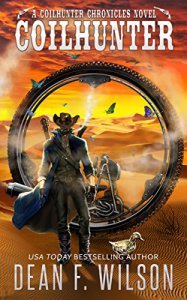
Coilhunter is a Weird Western by prolific indie author Dean F. Wilson. It’s the first in his Coilhunter series. The third book just came out last week, and all three are on Kindle Unlimited as of this writing. I plan on reviewing all three for reasons you’ll see below.
The story opens with a scene familiar to devotees of spaghetti Westerns. A lone lawmaker, made steampunk by the presence of an air filtering mask, waltzes into a saloon where a group of men are busying themselves with a poker game. He’s looking for an outlaw, and his mere presence strikes fear into the hearts of all four men. What follows is a quick action sequence where the Coilhunter showcases his gun-toting prowess and brings the body into the lawman’s office, only to find that his usual payment officer has disappeared.
This leads him to hunt down the people who murdered his friend…and eventually the people who murdered his family.
The writing style is a bit distant and many of the scenes felt ripped from the movies rather than realistic, but this is often the case for modern Westerns and Weird Westerns in particular, so I didn’t let it bother me too much. That said, some segments (particularly in the beginning) got a little tell-y, and I didn’t feel like I really sank into Nox’s point of view fully until around a third of the way through.
The world is rich and imaginative. Creatures encountered in the mines and through the desert on Nox’s journey felt threatening and (mostly) realistic, and even the minor characters were engaging and interesting. Dean’s real talents showcase themselves in dialogue. For a “man of few words,” Nox ends up speaking with others quite a bit, and his tongue-in cheek wit and no-nonsense approach to being his own lawman won me over by the end.
The greatest weaknesses in the piece came in toward the beginning and end. The opening tone was distant and as mentioned previously, I had a bit of a hard time sinking into the story until deeper in than I would’ve liked. The ending felt quite rushed and the final scene felt a little cliche, though I’m still interested in seeing where the series ends up going as a whole.
All and all an entertaining read.
4/5, I’ve already borrowed the next two and plan on reviewing them sometime next month.
March 6, 2018
Urban Fantasy Book Review: Gargoyle Guardian Chronicles Omnibus
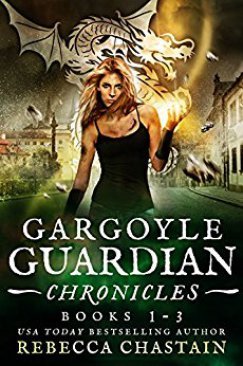
This is technically a review of three books by Rebecca Chastain, Magic of the Gargoyles, Curse of the Gargoyles, and Secret of the Gargoyles, all of which are packaged together in this bundle. I happened to pick it up for $0.99 on Kindle during a sale, so I definitely feel I got my money’s worth overall. I had varying opinions on each of the three books, and as such will handle each separately in this review.
Magic of the Gargoyles opens with a mid-level Earth Elemental (which took me a bit to figure out that by “elemental” the author meant magician, but we’ll get to that) named Mika Stillwater trying to repair some quartz containers for a demanding client. She has an unusual talent with quartz for someone at her power level, and manages to repair them perfectly despite most humans with talents similar to hers being unable to do that quality of work. Just as she’s sinking into the work, a beautiful panther gargoyle kit comes dashing into her home, thinking she’s a gargoyle and can help her save her friend.
She follows the kit and witnesses a terrorist act involving a fire gang that never shows up again, fueled by the life energy of the gargoyle’s littermate. This propels her into an action-packed (albeit brief) adventure in which she must rescue the rest of the litter from a wayward magician who auctions them off to the highest bidder. The worldbuilding is fantastic, as is the pacing. Her writing style is clean and readable, performing exactly as much as it needs to in order to get the story going. 5/5, it’s what led me to binge the next two books.
Curse of the Gargoyles opens up with the same client livid that her bottles weren’t finished, and one of the littermates from the first book has taken up residence in Mika’s apartment. She’s become a psuedo-celebrity as a gargoyle healer, and has taken up additional work along those lines. Soon she gets a call from the police department informing her that someone has begun insane experiments using gargoyle life energy again, this time involving separating the elements from inside the gargoyle’s bodies in defiance of nature.
This book spent more time working on defining the parameters of the magic system used in Chastain’s world, and although there was some character development and some fantastic descriptions, I didn’t find myself near as invested in the conflict in this second book. There was tension and danger, but the pacing felt off and most of the story felt like it was the same problem over and over again, more intellectual than emotional. 3/5. I still loved the characters from the first book, so I kept reading in the hopes things would get better.
Secret of the Gargoyles opens with the mystery presented at the end of Curse about a sleeping sickness that many humans had taken to be a part of the Gargoyle life cycle. After the dragon gargoyle who became her companion permanently at the end of Curse vouches for her in the presence of the mate to a sleeping gargoyle she attempts to heal (that was a mouthful), she’s declared a Gargoyle Guardian and given the secrets to eternal gargoyle life and healing, which the gargoyles deliberately kept hidden from all humans for millenia.
Mika enlists the help of one of her friends from the police force, a fire elemental she has a huge crush on but won’t admit her feelings to because she feels he’s out of her league, on a quest to delve into a dangerous area of wild magic where the key to healing the sick gargoyles lies.
This book had far better pacing than Curse, but didn’t quite live up to the potential in Magic. Chastain spends far too much time on the romantic subplot and not quite enough on the plot-plot for my tastes, though the climax and denoument were quite satisfying and in my opinion worth the wait. 4/5 stars, though I’m not sure how necessary Curse is to read in order to get here. I feel it could’ve been shortened to novella length or skipped over in favor of Magic straight into Secret.
4/5 overall for the series. I might check out the prequel/side story involving Mika’s best friend once she gets a few more books out. Not bad for $0.99.
Science Fiction Book Review: Reenu-You
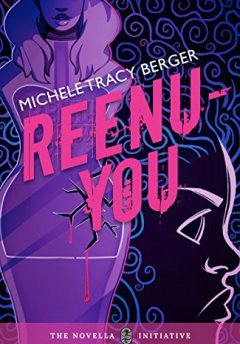
Disclaimer: I made the acquaintance of Michele Berger through the Fighting Monkey Press private author group on Facebook. I will assure you this did not affect my review, however, and she didn’t send me the book for review. I bought it because I was interested in the concept, and I was not disappointed.
All right, now that the disclaimer is out of the way, Reenu-You is a powerful post-apocalyptic alternate history hard sci-fi novella (man that’s a mouthful!) about a group of five women of color who each use a new, “natural” hair care product to relax their hair straight without needing additional products. Things turn for the worse when they each contract a nasty skin condition. The first protagonist we’re introduced to, Kat, is an African-American ski instructor who is introduced to the product by her best friend and cousin. She uses it and finds it works–but shortly afterwards discovers an awful skin rash that spreads in rings from the middle of her head.
After she goes to the doctor and is told they can’t help her (which is a brutally painful scene to read, as Berger does a fantastic job of capturing both the sexism and racism felt by minority women seeking any sort of medical help), she heads to the Center for Disease Control and is put in a room without being informed that she and the other five women in said room are under quarantine. This is where we meet Constancia, our other POV protagonist, a Puerto Rican woman obsessed with her appearance and who carries the painful burden of a troubled home life and rough relationship. She feels the only thing she has in life is her looks, so when the terrible affliction takes them away from her, she’s left emotionally decimated and lashes out on Kat in particular for her perceived “superiority complex.”
Berger does a fantastic job of developing both protagonists and their relationships to each other and the other three women they’ve come into unwitting contact with. The struggle for identity as a person of color with “white” interests is also well developed in the case of Kat, as is the struggle to relate to others of the same race when most of the character’s life has been spent around people of the dominant race. Hair is indeed political, and the idea that a hair care product was “dumbed down” in name in order to seem more “Ethnic” after a once POC-owned company was purchased by a predominantly white pharmaceutical firm was a nice touch, although disheartening in how realistic it was.
Her style is highly readable and I found myself binge-reading the book within a few hours of picking it up. Given how much I read these days, this is a rarer and rarer thing.
5/5, well worth your time and attention.
March 1, 2018
Fantasy Book Review: The War Ender’s Apprentice
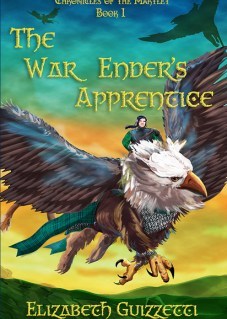
The War Ender’s Apprentice is the first book in the Chronicles of the Martlet series by Elizabeth Guizetti, and also the self-professed first novella by the author.
It stars three main characters. The majority of the book is in the point of view of Alana, the Martlet (third born noble elf) in House Eyreid and aging War Ender for the mysterious Guild. The story opens with her and the soon to be second protagonist Roark, her nephew, on a ship carrying slaves from her own lands. The Guild contract was simply to collect a debt, and policy dictates that she must obey the laws in the country she takes the contract in, but her oaths as a Martlet overwhelm the Guild rules in her mind, so she rescues the slaves and releases them.
Among them we meet our third protagonist, Eohan, whom Alana sees in a vision as being key to Roark’s future within their noble family. She takes him as an apprentice, and soon they’re assigned a war to end.
Without giving too much more away, the war ending portion that follows is where the novel really shines. Guizzetti’s skill as a world builder is top notch. Even though the hierarchy systems (and the politics between her various races) are complex and unique, she works enough explanation through action and character thought that I was able to follow, without having to resort to the oh-too-familiar info-dumps commonly found in epic fantasy novels. Each of her races felt specifically unique to her work, and the brief encounters with blood magic and magic involving the afterlife gave me a taste of what could potentially follow in the rest of the series.
Her non human characters also felt non-human, as opposed to being some exaggeration of human qualities or race relations masquerading as characters. This is a bugbear of mine in epic fantasy, and I’ve only seen it done right in a handful of books. This is one of them.
The e-book’s formatting was a little rough, and in some places the chapter breaks didn’t fall where they needed to, but the storytelling was compelling enough that I perked an eyebrow and moved on.
4.5/5, looking forward to the next book in the series.



